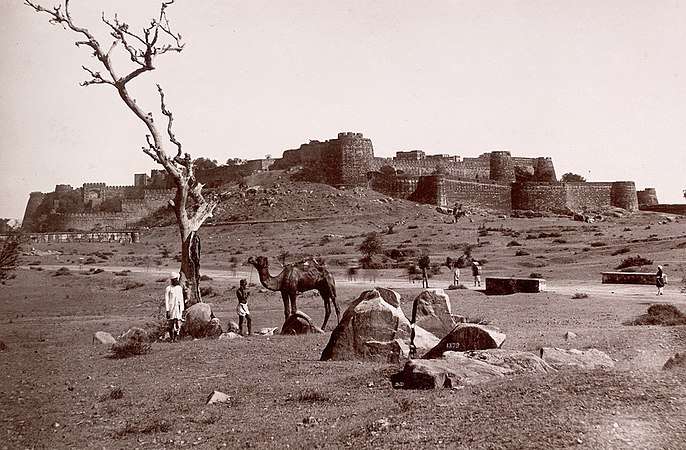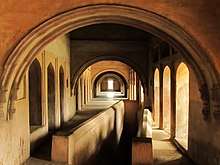Jhansi Fort
Jhansi Fort or Jhansi ka Kila is a fortress situated on a large hilltop called Bangira, in Uttar Pradesh, Northern India. It served as a stronghold of the Chandela Kings in Balwant Nagar from the 11th through the 17th century.
| Jhansi Fort | |
|---|---|
| Part of Bundelkhand | |
| Jhansi, Uttar Pradesh | |
Jhansi Fort, 2009 | |
 Jhansi Fort | |
| Coordinates | 25.4581258°N 78.5753775°E |
| Height | 285mt. |
| Site information | |
| Owner | Govt. of India |
| Open to the public | yes( 7am to 6pm) |
| Condition | Good |
| Site history | |
| Materials | Stone, Lime and Lead |
| Battles/wars | Battle of Jhansi |
| Garrison information | |
| Occupants | Maratha Empire,Peshwa, Newalkar, and Scindia, British |
How to reach
The Jhansi fort is located in the middle of the Jhansi city. It is 3 km from the Jhansi Railway station. The nearest airport is Gwalior, which is 103 km from Jhansi.[1] You can also reach the fort by getting down at the Jhansi Museum Bus Stop.[2]
History
The construction of the Jhansi fort is ascribed to the Bundela Rajput chief and the ruler of the kingdom of Orchha Veer Singh ju Deo Bundela in 1613. It is one of the strongholds of the Bundelas. In 1728, Mohammed Khan Bangash attacked Maharaja Chattrasal. Peshwa Bajirao [3] helped Maharaja Chattrasal defeat the Mughal army. As a mark of gratitude, Maharaja Chattrasal offered a part of his state, which included Jhansi, to Peshwa Bajirao. In 1742 Naroshanker was made the subedar of Jhansi. During his tenure of 15 years he not only extended the strategically important Jhansi fort (the extension is called Shankergarh), but also constructed other buildings. In 1757, after Naroshanker was called back by the Peshwa. Madhav Govind Kakirde and then Babulal Kanahai were made the subedars of Jhansi. From 1766 to 1769 Vishwas Rao Laxman served as the subedar of Jhansi. Then Raghunath Rao (II) Newalkar was appointed the subedar of Jhansi. He was a very able administrator, increasing the revenue of the state and building both the MahaLakshmi Temple and the Raghunath Temple.
After the death of Shiv Rao his grandson Ramchandra Rao was made subedar of Jhansi. His poorly administered term ended with his death in 1835. His successor Raghunath Rao (III) died in 1838. The British rulers then accepted Gangadhar Rao as the Raja of Jhansi. The inefficient administration of Raghunath Rao (III) left Jhansi in a very poor financial position.


However, he was succeeded by Raja Gangadhar Rao, who was a very good administrator. He was reportedly very generous and sympathetic, and the local population of Jhansi was well satisfied. In 1842 Raja Gangadhar Rao married Manikarnika Tambe who was the given the new name of Lakshmi Bai. She gave birth to a boy, later named Damodar Rao, in 1851, who died after four months.[4] The Maharaja adopted a child called Anand Rao, the son of Gangadhar Rao's cousin, who was renamed Damodar Rao, on the day before the Maharaja died. The adoption was in the presence of the British political officer who was given a letter from the Maharaja instructing that the child be treated with respect and that the government of Jhansi should be given to his widow for her lifetime. After the death of the Maharaja in November 1853, because Damodar Rao (born Anand Rao) was adopted, the British East India Company, under Governor-General Lord Dalhousie, applied the Doctrine of Lapse, rejecting Damodar Rao's claim to the throne and annexing the state to its territories. In March 1854, Lakshmibai was given an annual pension of Rs. 60,000 and ordered to leave the palace and the fort. In June 1857 the revolt broke out and she took the control of the fort and led Jhansi forces against those of the British East India Company.[5]
Jhansi was besieged by the company forces of General Hugh Rose in March and April 1858 and was captured on 4 April 1858. Rani Lakshmi Bai fought bravely and then made a daring escape on horseback from the fort before the city was pillaged by Rose's troops.[5][6][7]
In 1861 the British Government gave the Jhansi fort and Jhansi city to Jiyaji Rao Scindia, the Maharaja of Gwalior, but the British took back Jhansi from Gwalior state in 1868.
Structure

The fort standing in the hilly area shows how the North Indian style of fort construction differs from that of the South. In the South most of the forts were built on the sea beds like the Bekal Fort in Kerala. The granite walls of the fort are between 16 and 20 feet thick and on the south side the city walls meet. The south face of the fort is almost perpendicular.[8] There are 10 gates giving access to the fort. Some of these are Khanderao Gate, Datia Darwaza, Unnao Gate, badaGao gate, Laxmi Gate, Sagar Gate, Orchha Gate, Sainyar Gate and Chand Gate. Notable sights in the fort are the Shiva temple, Ganesh temple at the entrance, and the Kadak Bijli cannon used in the uprising of 1857. The memorial board reminds one of the hair-raising feat of the Rani Lakshmibai in jumping on horseback from the fort. Nearby is the Rani Mahal, built in the later half of the 19th century where there is now an archaeological museum.
The fort extends to a sprawling 15 acres (61,000 m2) and this colossal structure measures about 312m in length and 225m in width. On the whole, there are twenty-two supports with a mammoth strengthening wall surrounded by a moat on both sides. The shattered upholder on the eastern side was rebuilt by the British, who also added a floor to Panch Mahal.

Events
Every year in the month of January–February a grand occasion is held known as Jhansi Mahotsav when many eminent personalities and artists perform their play.[9]
See also
- Central India Campaign (1858)
- Rani of Jhansi
- Gangadhar Rao
References
- https://www.ixigo.com/jhansi-fort-jhansi-india-opening-visiting-timing-hours-closed-days-ne-1048121
- https://www.neotravellers.com/jhansi-fort-worth-a-visit/
- Baji Rao I
- "On Rani Lakshmibai's Birth Anniversary, Here Are Rare Facts About Queen Of Jhansi - News Nation". NewsNation. Retrieved 10 December 2019.
- World, Republic. "PM Narendra Modi pays tributes to Rani Lakshmi Bai on her birth anniversary". Republic World. Retrieved 10 December 2019.
- Vishnubhat Godse has recorded what he knew of this in his Maza Praavas.
- "Rani Laxmi Bai Birth Anniversary: All you need to know about the queen who became an icon of the freedom struggle". Firstpost. Retrieved 7 December 2019.
- Edwardes, Michael (1975) Red Year. London: Sphere Books; p. 119
- "Independence Day: 6 monuments that played a significant role during the Indian freedom struggle". Architectural Digest India. 15 August 2019. Retrieved 7 December 2019.